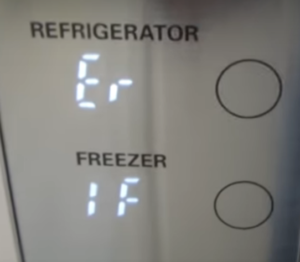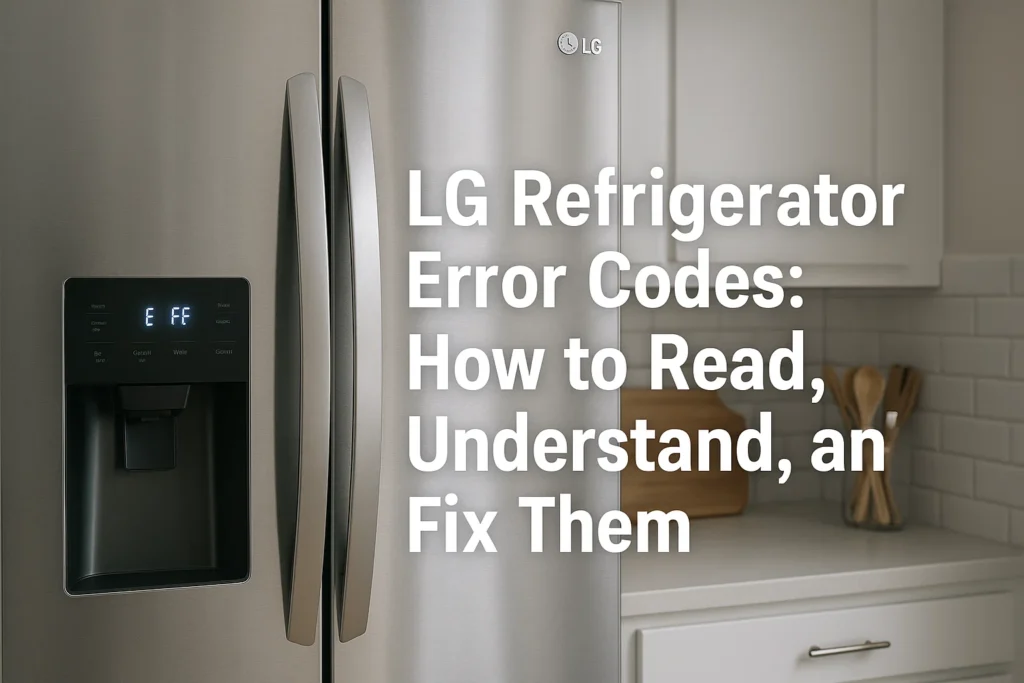How to Read Error Codes

LG refrigerators are designed with a built-in diagnostic system that displays error codes whenever something goes wrong. These codes are essentially messages from your appliance, letting you know which component requires attention.
Where Are Error Codes Displayed?
Most LG models show error codes directly on the digital control panel, typically located inside the fridge compartment or on the front display. In some cases, the fridge may also beep or flash indicator lights to draw your attention.
How to Trigger an Error Code Manually

If you suspect an issue but don’t see any code, many LG refrigerators allow you to run a manual diagnostic test. Usually, this involves pressing a combination of buttons—such as holding the “Power Cool” and “Power Freeze” buttons simultaneously for 5 seconds—though the exact method depends on the model. The manual will provide the correct button sequence for your unit.
What Do the Most Common Codes Mean?
Below is a list of frequently seen LG refrigerator error codes with quick explanations and fixes:
| No. | Error Code | Symptom | Possible Cause |
|---|---|---|---|
| 1 | EFS | Freezer sensor defect | Sensor short-circuited or disconnected |
| 2 | ErS | Refrigerator sensor defect | Sensor short-circuited or disconnected |
| 3 | ESS | Pantry sensor defect | Sensor short-circuited or disconnected |
| 4 | EIS | Ice-room sensor defect | Sensor short-circuited or disconnected |
| 5 | FdS | Freezer defrost sensor defect | Short circuit or sensor disconnected |
| 6 | Ert | Room temperature sensor defect | Sensor short-circuited or disconnected |
| 7 | EHS | Humidity sensor defect | Sensor short-circuited or disconnected |
| 8 | EId | Freezer ice maker sensor defect | Sensor short-circuited or disconnected |
| 9 | EIO | Mini ice maker sensor defect | Sensor short-circuited or disconnected |
| 10 | EIt | Ice maker kit defect | Ice maker motor malfunction |
| 11 | EIU | Freezer ice maker kit defect | Ice maker motor malfunction |
| 12 | EIC | Mini ice maker kit defect | Ice maker motor malfunction |
| 13 | EgF | Flow meter error | Faulty flow meter or no water supply |
| 14 | FdH | Defrost failure | Defrost sensor not reaching 40℉ (5℃) within 80 minutes |
| 15 | EFF | Freezer fan motor error | No feedback signal from motor for 65+ seconds |
| 16 | EIF | Ice maker fan motor error | No feedback signal from motor for 65+ seconds |
| 17 | ECF | Mechanical room fan error | No feedback signal from motor for 65+ seconds |
| 18 | ECO | Communication error | Main MICOM not communicating with display MICOM |
| 19 | ESd | Sub communication error | Main MICOM not communicating with Sub MICOM |
| 20 | EOd | Wi-Fi modem error | Modem defect or MICOM connection failure |
| 21 | ECH | High-side cycle leakage | Refrigerant leak, bad valve, or compressor fault |
| 22 | ECL | Low-side cycle leakage | Refrigerant leak, long door open, or weak compressor |
| 23 | rdS | Defrost sensor error | Sensor shorted or disconnected |
| 24 | ErF | Refrigerator fan motor error | Fan feedback signal missing for 65+ seconds |
| 25 | EUC | UV Nano LED module error | Faulty UV LED or poor connection |
| 26 | Elt | Ice maker motor fault | Step motor or driving circuit failure |
| 27 | Ett | Water tank switch error | Tank not assembled correctly or switch defective |
| 28 | EdS | Defrost sensor error | Sensor shorted or disconnected |
| 29 | ECS | Convertible/pantry sensor error | Sensor shorted or disconnected |
| 30 | Ead | Auto door module problem | Faulty sensor, motor, or connection |
| 31 | EAS | Auto door reed switch error | Loose or faulty connector |
| 32 | EdL | Left drawer module error | Faulty sensor, motor, or connection |
| 33 | LAS | Left drawer reed switch error | Connector issue |
| 34 | Edr | Right drawer module error | Faulty sensor, motor, or connection |
| 35 | rAS | Right drawer reed switch error | Connector issue |
| 36 | EC1 | LCD–dispenser comm error | Connection or transmission defect |
| 37 | ErC1 | Top display–dispenser error | MICOM communication failure |
| 38 | dSF | Freezer defrost sensor error | Sensor shorted or disconnected |
| 39 | HSE | Humidity sensor error | Sensor shorted or disconnected |
| 40 | ISE | Icing sensor error | Ice maker sensor defect |
| 41 | SSE | Pantry sensor error | Sensor shorted or disconnected |
| 42 | rtE | Room temp sensor error | Sensor shorted or disconnected |
| 43 | ItE | Ice maker kit defect | Motor, gear, or circuit malfunction |
| 44 | dHF | Defrosting error | Sensor not above 46°F (8℃) after 80 minutes |
| 45 | FFE | Freezer fan motor abnormality | Fan feedback missing for 65+ seconds |
| 46 | CFE | Mechanical room fan abnormality | Fan feedback missing for 65+ seconds |
| 47 | COE | Communication error | Main PCB MICOM not linked with display MICOM |
Simple Troubleshooting You Can Try
Before calling for service, try these basic steps:
- Reset the refrigerator by unplugging it for 5–10 minutes.
- Defrost the unit if you notice heavy ice buildup.
- Check fans and airflow to ensure they are not blocked by food items.
- Inspect sensors and wiring for visible damage.
When to Call a Specialist
Certain circumstances require immediate professional help:
- The fridge stops cooling completely.
- Error codes reappear after a reset.
- You hear loud noises from the compressor or fan.
- There’s a burning smell or electrical issue.
In such cases, don’t wait. Contact a reliable service like Express Repair, which provides urgent fridge repair in New York with same-day appointments.
Prevention: Keeping Your Refrigerator Healthy
Regular care can prevent many error codes from appearing in the first place. A few habits go a long way:
- Clean condenser coils every six months to prevent overheating.
- Defrost when needed to keep sensors and fans from freezing over.
- Avoid overloading shelves, since blocked airflow stresses the cooling system.
- Check door seals regularly to ensure energy efficiency.
- Monitor temperature settings and adjust for seasonal changes.
By combining proper maintenance with timely troubleshooting, you’ll extend your LG refrigerator’s lifespan and reduce the need for costly repairs. Facing issues with your fridge? Our certified technicians provide reliable LG Refrigerator Repair in New York to quickly diagnose and fix the problem, ensuring your appliance runs like new.
